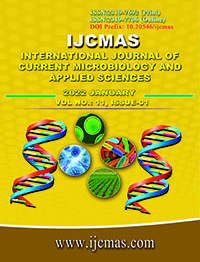


 National Academy of Agricultural Sciences (NAAS)
National Academy of Agricultural Sciences (NAAS)

|
PRINT ISSN : 2319-7692
Online ISSN : 2319-7706 Issues : 12 per year Publisher : Excellent Publishers Email : editorijcmas@gmail.com / submit@ijcmas.com Editor-in-chief: Dr.M.Prakash Index Copernicus ICV 2018: 95.39 NAAS RATING 2020: 5.38 |
There is a need to reduce the use of chemical fertilizers for sustaining soil health and to reduce the cost of cultivation and that without compromising the yield of crop. The present study deals with the effect of different biofertilizers along with reduced levels of recommended dose of NPK fertilizers on flower yield and economics of chrysanthemum (Chrysanthemum morifolium Ramat. Syn. Dendranthema grandiflora) variety ‘White Star’. This experiment was carried out during 2019-2020 and was laid out in Randomized Block Design (RBD) under field condition with three replications, using eleven treatments comprising of combinations of three levels of recommended dose of NPK (100% RDF, 80% RDF and 60% RDF) and four biofertilizers (Azotobacter, PSB, KMB and NPK consortia). The results revealed that among various treatments, maximum number of flowers per plant (10.40), number of flowers per plot (82.92) and number of flowers per hectare (11.51 lakh) were recorded in treatment 80% RDF + NPK consortia which was higher compared to the treatment with recommended dose of chemical fertilizers. Maximum gross income (17, 27,499), net income (12, 58,491) and benefit cost ratio (2.68) was obtained in the same treatment.
 |
 |
 |
 |
 |